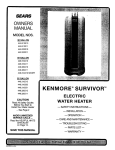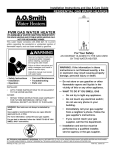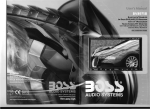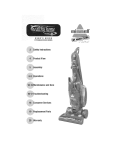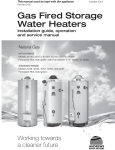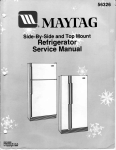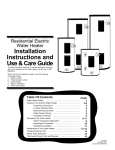Download Whirlpool E2F40LD045 Installation manual
Transcript
Whi l
Water
ol
TM
Heaters
Residential Electric
Water Heater
lnstallati
n
lnst
ct"
n
Use Care Gu"
To obtain technical, warranty or service assistance during or
after the installation of this water heater, call toll free 1-877817-6750
When calling for assistance, please have the following
information ready:
1. Model number
2. 7 Digit product number
3. Serial number
4. Date of installation
5. Place of Purchase
Table Of Contents
PAGE
Water Heater Safety
.....................................................................
Installing Your Electric Water Heater
........................................
Unpacking Instructions
Location Requirements
2
3-8
................................................
................................................
4
Electrical Requirements
...............................................
Water System Piping
...................................................
5
6
Installation Checklist
Operating Your Water Heater
....................................................
.......................................................
Water Temperature Regulation
....................................
Adjusting the Thermostat .....................................................
3
8
9-11
9
10
Operational Conditions ........................................................
11
Maintenance of Your Water Heater ................................................. 12-1 3
Trouble Shooting Chart
Repair Parts Illustration
.............................................................
.............................................................
Thermostat Wiring Chart and Diagram
.....................................
14
15
16
6510194
JULY 2000
Your safety
and the safety of others are very
important.
We have provided many important safety messages in this manual and on your appliance. Always read and obey all
safety messages.
This is the safety alert symbol.
This symbol alerts you to potential hazards that can kill or hurt you and others.
All safety messages will follow the safety alert symbol and either the word "DANGER" or
"WARNING." These words mean:
You can be killed or seriously injured if you don't
immediately follow instructions.
You can be killed or seriously
follow instructions.
injured if you don't
All safety messages will tell you what the potential hazard is, tell you how to reduce the chance of injury, and tell you
what can happen if the instructions are not followed.
Important
Safety
Instructions
CAUTION: Hydrogen gas is produced in a hot water system served by this heater that has not been used for a long
period of time (2 weeks or more). Hydrogen is extremely flammable. To reduce the risk of injury under these conditions,
it is recommended that the hot water faucet be opened for several minutes at the kitchen sink before using any electrical
appliance connected to the hot water system. When hydrogen is present, there will be an unusual sound such as air
escaping through the pipe as the water begins to flow. There should be no smoking or open flame near the faucet at
the time it is open.
The California Safe Drinking Water and Toxic Enforcement Act requires the Governor of California to publish a list of
substances known to the State of California to cause cancer, birth defects, or other reproductive harm, and requires
businesses to warn of potential exposure to such substances.
Warning:
This product contains a chemical known to the State of California to cause cancer, birth defects, or other
reproductive harm.
This appliance can cause low-level exposure to some of the substances listed, including formaldehyde.
INSTALLING
Consumer
YOUR WATER
information
This water heater should be installed in accordance with
the local code authority having jurisdiction, the power
company or electric utility, and this installation manual.
In the absence of local code requirements, follow the
regulations set forth in the latest edition of The National
Electric Code, NFPA 70. This is available from the
following:
National Fire Protection Agency
1 Batterymarch Park
Quincy, MA 02269
American National Standards Institute
1430 Broadway
New York, NY 10018
Check your phone listings for the local authorities having
jurisdiction over your installation.
Consumer
Responsibilities
This manual has been prepared to acquaint you with the
installation, operation and maintenance of your electric
water heater and to provide important safety information
in these areas.
We urge you to read all of the instructions thoroughly
before attempting the installation or operation of this
water heater. This manual should be kept for future
reference.
The manufacturer of this water heater will not be liable
for any damages caused by failure to comply with the
installation and operating instructions outlined in this
manual.
If you lack the necessary skills required to properly install
this water heater or you have difficulty following the
directions, you should not proceed but have a qualified
person perform the installation of this water heater.
A data plate identifying your water heater can be found
adjacent to the element door. When referring to your
water heater always have the information listed on the
data plate readily available.
Retain your original receipt as proof of purchase.
HEATER
Unpacking
the Water Heater
Excessive Weight Hazard
Use two or more people to move and install
water heater.
Failure to do so can result in back or other
injury.
Removing
Packaging
Materials
Important: Do not remove any permanent instructions,
labels, or the data label from outside of the water heater
or on the inside of panels.
Remove exterior packaging and place installation
components aside.
Inspect all parts for damage prior to installation
and start-up.
Completely read all instructions before attempting
to assemble and install this product.
After installation, dispose of packaging material
in the proper manner.
Note: The water heater shall be located so it is not subject
to physical damage by moving vehicles or area flooding.
Location Requirements
Site location
Select a location near the center of the water piping
system. It must be installed indoors and in a vertical
position on a level surface.
The water heater should be located in an area not subject
to freezing temperatures. Water heaters located in
unconditioned spaces (i.e., attics, basements, etc.) May
require the water piping and drain piping to be insulated
to protect against freezing. The drain and controls must
be easily accessible for operation and service.
Do not use this water heater in conjunction with a spa
or hot tub.
FIG URE 1
RESIDENTIAL
INS'IS_LLATION
GARAGE
VEHICLE
STOP
DRAIN_
DRAIN
PAN
Note: Local codes and requirements in your area may
require the installation of your water heater be
accomplished in a way that the bottom element is elevated
from the floor at least 18 inches.
Important: The water heater should be located in an
area where leakage of the tank or connections will not
result in damage to the area adjacent to the water heater
or to lower floors of the structure. Due to the normal
corrosive action of the water, the tank will eventually leak
after an extended period of time. It is recommended that
a suitable drain pan be installed under the water heater
as shown below. This pan is to protect the property from
damage which may occur from normal condensate
formation on the tank or leaks in the tank and pipe
connections. The pan must limit the water level to a
maximum depth of 2-1/2 inches and be two inches wider
than the heater and piped to an adequate drain. Locate
the water heater near a suitable indoor drain. Outside
drains are subject to freezing temperatures which can
obstruct the drain line. The piping should be at least 3/4"
ID and pitched for proper drainage.
Under no circumstance will the manufacturer be held
liable for any water damage in connection with this
water heater.
2 1/2" MAX
t
PIPE
TO
ADEQUATE
DRAIN
A
TITAN
TIlE DIAMETER
_\_A.TER HEATER.
OF TItE
State of California
Note: The water heater must be braced, anchored, or
strapped to avoid moving during an earthquake. Contact
local utilities for code requirements in your area or call
1-877-817-6750 and request instructions.
Electrical Requirements
FIGURE
2
HEATING
ELEMENT
, /
Electrical
Bang
Shock Hazard
Disconnect power before
servicing.
Replace all parts and panels
before operating.
Failure to do so can result in
death or electrical shock.
Fire Hazard
Use 10 gauge solid copper wire.
Use a UL approved strain relief.
Connect ground wire to green
ground screw.
Failure to do so can result in
death, fire, or electrical shock.
If you lack the necessary skills required to properly install
the electrical wiring to this water heater, do not proceed
but have a qualified electrician perform the installation.
When making the electrical connections, always make
sure:
The electrical supply has the proper overload fuse
or breaker protection.
I
Notice: Applying electrical power to elements that are not
submerged in water will destroy them. The manufacturer
will not warranty any elements damaged in this manner.
FIGURE
3
120/240V
2-WIR, E MODELS
JUNCTION
COVER
BOX
GROUND
WIRE
GREEN
GROUND
SCREW
CONSULT
Io
XRLACK
WlltTE
WIRE
(120V
MODELS)
RED WIRE
(240V
MODELS)
FIGURE
4
WIRING
DIAG RAM
120V MODELS
ONLY
APPROVED
Wire sizes and connections comply with all
applicable codes.
B_,ACK
__o
OVERLOAD
PROTECTION
CONNECTORS
CIRCUIT
_
_'_
\_ HtTE
Wiring enclosed in approved conduit (if required
by local codes).
WIRE
#
:-#
"_
BREAKER
..... :.OT
12o/16ov
_
_
m
_
POWER
SUPPLY
i__
I
:
_
:.........
The water heater and electrical supply are properly
grounded.
Figures 3, 4, and 5 are provided as reference drawings
for the 120!240v 2-wire models only. Always reference
the wiring diagram located on the water heater for the
correct electrical connections.
i NEUTRAL
__L____
J
GROUND
ELECTRICAL
SERVICE
GROUND
When installing the electrical wiring to the water heater:
1.
Be sure tank is completely filled with water before
making any electrical connections. (See Figure 2)
2.
Shut-off the power to the unit.
3.
Loosen the screw holding the junction box cover
to the top of the water heater. Set the cover aside.
FIGURE
5
WIRING
208/240V
DIAGRAM
MODELS
ONLY
OVERLOAD
PROTECTION
APPROVED
CONNECTORS
CIRCUIT
_
S
........
4.
5.
Connect the electrical supply to the water heater
in accordance with local utility requirements and
codes. A standard 1/2 inch opening has been made
in the junction box for conduit connections.
Ground the water heater by connecting a grounding
wire from the electrical service ground terminal to
the green grounding screw in the junction box of
the water heater.
__BLACK
BREAKER
I
',
L1
,
208 240V
|
|
',
-GROUND
"-..
:
c. 6om
Z-...........
P()_R
ELECTRICAL
SERVICE
GROUND
SUPP[X
Water System Piping
FIG URE 6
WATER
PIPING
Piping Installation
Piping, fittings, and valves should be installed according
to the installation drawing (Figure 6). If the indoor
installation area is subject to freezing temperatures, the
water piping must be protected by insulation.
b_,,/
Important: Always use a good grade of joint compound
and be certain that all fittings are drawn up tight
1
Install the water piping and fittings as shown in the
Figure 6 Connect the cold water supply (3/4 NPT)
to the fitting marked '%" Connect the hot water
supply (3/4 NPT) to the fitting marked "H"
Important: Some models may contain energy saving
heat traps to prevent the circulation of hot water within
the pipes Do not remove these inserts
2 The installation of unions in both the hot and cold
water supply lines are recommended for ease of
removing the water heater for service or replacement
3 The manufacturer of this water heater recommends
installing a tempering valve in the domestic hot water
line as shown in Figures 7 and 8 These valves reduce
the point-of-use temperature of the hot water by
mixing cold and hot water and are readily available
Contact a licensed plumber or the local plumbing
authority
4
5
.
7.
SYSTEM
1.
TIIERMALEXPANSIONTANK
2.
PRESSURE
RELIEF
YALVE
Y_L\'E WITII BYPASS
PRESSURE
REDUCING
ltOT WATER
OUTLET
COLDINLET
WATER
COLD
INLET
Water supply pressure should not exceed 80% of the
working pressure of the water heater. The working
pressure is stated on the water heater's data plate. If
this occurs a pressure limiting valve with a bypass may
need to be installed in the cold water supply line. This
should be placed on the supply to the entire house in
order to maintain equal hot and cold water pressures.
Important: Heat cannot be applied to the water fittings
on the heater as they may contain nonmetallic parts If
solder connections are used, solder the pipe to the
adapter before attaching the adapter to the hot and cold
water fittings
IN A CLOSED
USE EITIIER:
INSTALLATION
PRESSURE
RELIEF
DtSCIIARGE
ABOYE
DRAIN
_&_TER
VALVE
VALVE
LINE
DRAIN
LINE
3/4 tNCll
tD
MINIMUM
DRAIN
i
Tills
ILLUSTRATION
NOT MEET TIIE CODE
TIlE COMMONWEALTII
MASSACIIUSETTES.
DRAIN PAN _
2-1/2 INCH DEPTII
MAX.
FIG URE 7
TEMPERING
VALVE
SIDE WATER CONNECTIONS
FOLLOW
TIlE
TEMPERING
VALVE'S
MANUFACTURER'S
INSTALLATION
INSTRUCTIONS
IlOT
WATER
OUT
TEMPERED
WATER
TO FIXTURES
TEMPERING
_5_LYE
SET TO 120 ° F MAXIMUM
COLD WATER 1N
FIGURE 8
TEMPERING
VALVE
TOP WATER CONNECTIONS
V_;&TER
INLET
COLD
FOLLOW
TIIE TEMPERING
VALVE MANUFACTURER'S
INSTRUCTIONS
If installing the water heater in a closed water system,
install a relief valve or expansion tank in the cold
water line as specified under "Closed System/Thermal
Expansion"
Install a shut off valve in the cold water inlet line It
should be located close to the water heater and be
easily accessible Know the location of this valve and
how to shut off the water to the heater
Install a temperature and pressure relief valve and
discharge line in the opening marked "T & P RELIEF
VALVE" Install as specified under "Temperature and
Pressure Relief Valve"
After piping has been properly connected to the water
heater, open the nearest hot water faucet and allow
the tank to completely fill with water To purge the
lines of any excess air and sediment, keep the hot
water faucet open for 3 minutes after a constant flow
of water is obtained Close the faucet and check all
connections for leaks
TEMPERED
WATER TO
FIXTURES
TEMPERING
VALVE
(SETTO
120 ° F)
DOES
OF
OF
i
Please note the following:
DO NOT install this water heater with iron piping. The
system should be installed only with new piping that
is suitable for potable (drinkable) water such as copper,
CPVC, or polybutylene. DO NOT use PVC water
piping.
Temperature
Relief Valve
and Pressure
DO NOT use any pumps, valves, or fittings that are
not compatible with potable water.
DO NOT use valves that may cause excessive
restriction to water flow. Use full flow ball or gate
valves only.
DO NOT use 50/50 tin-lead solder (or any lead based
solder) in potable water lines. Use 95/5 tin-antimony
or other equivalent material.
DO NOT tamper with the thermostat, heater elements,
electrical connections, or temperature and pressure
relief valve. Tampering voids all warranties. Only
qualified technicians should service these components.
DO NOT use with piping that has been treated with
chromate's, boiler seal, or other chemicals.
DO NOT add any chemicals to the system piping
which will contaminate the potable water supply.
Closed
System/Thermal
Expansion
Periodic discharge of the temperature and pressure
relief valve may be due to thermal expansion in a closed
water supply system. The water utility supply meter may
contain a check valve, backfiow preventer or water
pressure reducing valve. This will create a closed water
system. During the heating cycle of the water heater,
the water expands causing pressure inside the water
heater to increase. This may cause the temperature
and pressure relief valve to discharge small quantities
of hot water. To prevent this from happening, there are
two recommendations:
Install a diaphragm-type expansion tank that is
suitable for potable water on the cold water supply
line. The expansion tank must have a minimum
capacity of 1.5 U.S. gallons for every 50 gallons
of stored water.
2.
Install a 125 PSI pressure relief valve in the cold
water supply line. Make sure the discharge of
this valve is directed to an open drain and
protected from freezing.
Contact the local water supplier or plumbing inspector
for information on how to control this situation. Do not
plug the temperature and pressure relief valve.
Explosion
Hazard
If the temperature
and pressure relief valve
is dripping
or leaking, have a licensed
plumber repair it.
Do not plug valve.
Do not remove valve.
Failure to follow these instructions
result in death, or explosion.
FIGURE
9
TEMPERATURE
RELIEF
VALVE
AND PRESSURE
INSTALLATION
j--
OPTION
_L LOCATII)N
SO_IE
_II)DELS
ONIflt'
DIS(
HAR(;E
DO NOT
DRAIN
can
(_P
LINE
OR
PLUG
P_N
6 INCH
[
DRAIN
For protection against excessive pressures and
temperatures, a temperature and pressure relief valve
must be installed in the opening marked "T & P RELIEF
VALVE" (See Figure 9).
Caution: To reduce the risk of excessive pressures and
temperatures in this water heater, install temperature
and pressure relief protective equipment required by
local codes, but no less than a combination temperature
and pressure relief valve certified by a nationally
recognized testing laboratory that maintains periodic
inspection of the production of listed equipment or
materials, as meeting the requirements for Relief Valves
and Automatic Shutoff Devices for Hot Water Supply
Systems, ANSI Z21.22 - 1986. This valve must be marked
with the maximum set pressure not to exceed the marked
maximum working pressure of the water heater. Install
the valve into an opening provided and marked for this
purpose in the water heater, and orient it or provide
tubing so that any discharge from the valve exits only
within 6 inches above, or at any distance below, the
structural floor, and does not contact any live electrical
part. The discharge opening must not be blocked or
reduced in size under any circumstance.
Important:Onlya newtemperature
andpressurerelief
valveshouldbeusedwithyourwaterheater.Donotuse
anoldor existingvalveasit maybedamagedor not
adequate
fortheworkingpressureofthenewwater
heater.Donotplaceanyvalvebetweenthereliefvalve
andthetank.
Installation
Water Heater Location
Centrally located with the water piping system.
Located indoors and in a vertical position. Protected
from freezing temperatures.
The Temperature & Pressure Relief Valve:
Must not be in contact with any electrical part.
Provisions made to protect the area from water
damage. Drain pan installed and piped to an
adequate drain.
Sufficient room to service the water heater.
Must be connected to an adequate discharge line.
Must not be rated higher than the working pressure
shown on the data plate of the water heater.
The Discharge
Line:
Must not be smaller than the pipe size of the relief
valve or have any reducing coupling installed in
the discharge line.
Water System
o
o
Piping
Temperature and pressure relief valve properly
installed with a discharge line run to an open drain
and protected from freezing.
Must not be capped, blocked, plugged or contain
any valve between the relief valve and the end of
the discharge line.
o
Check List
All piping properly installed and free of leaks.
Heater completely filled with water. (See Figure 2)
Must terminate a maximum of 6 inches above a
floor drain or external to the building.
Closed system pressure buildup precautions
installed.
Must be capable of withstanding 250°F (121 °C)
without distortion.
Tempering valve installed per manufacturer's
instructions.
Must be installed to allow complete drainage of
both the valve and discharge line.
Solar Installation
If this water heater is used as a solar storage heater or
as a backup for the solar system, the water supply
temperatures to the water heater tank may be in excess
of 120°F. A tempering valve or other temperature limiting
valve must be installed in the water supply line to limit
the supply temperature to 120°F.
Note: Solar water heating systems can often supply
water with temperatures exceeding 180°F and may result
in water heater malfunction.
Electrical
Connections
o
Wiring and connections comply with all applicable
codes.
o
Water heater and electrical supply are properly
grounded.
o
Proper overload fuse or circuit breaker protection
installed.
OPERATING
Before operating
following:
YOUR
WATER
the water heater, perform the
1. Make sure the water heater has been properly
installed.
HEATER
Water Temperature
Regulation
2. Completely fill the tank with water. (See Figure 2)
3. Apply power to the water heater only after the tank
is completely filled with water.
4. Carefully read and understand the "Water
Temperature Regulation" section of this manual.
5. Adjust the thermostat to the desired temperature
setting as directed under "Adjusting the Thermostat/
High Limit Control".
Important: Do not attempt to operate this water heater
if the thermostat(s), or surrounding insulation has been
exposed to water in any way. Immediately call a qualified
service technician to inspect the water heater and replace
any thermostat or insulation that has been exposed to
water. Do not attempt to repair these parts. Water heaters
subjected to flood conditions or any time the thermostat(s)
have been submerged in water require replacement of
the entire water heater.
Safety Shut=off
This water heater is designed to automatically shut-off
in the event that the water temperature exceeds 170°F
(77°C). A high limit control switch is used to shut off the
power to the elements if the water temperature exceeds
170°F (77°C). The high limit control can be reset by
firmly pushing in the red reset button located on the
thermostat. Follow the instructions under "Adjusting the
Thermostat/High Limit Control" to properly reset the high
limit control.
Water temperature
over 125°F can cause
severe burns instantly or death from
scalds.
Children,
disabled
and elderly
highest risk of being scalded.
are at
See instructions
manual before
temperature
at water heater.
Feel water
Temperature
before
bathing
setting
or showering.
limiting valves
are available.
The thermostat is adjusted to a temperature setting of
120°F or lower when it is shipped from the factory.
Water temperature can be regulated by adjusting the
thermostat to the preferred setting as shown in "Adjusting
the Thermostat/High limit Control." The preferred
starting point is 120°F. There is a hot water scald
potential if the thermostat is set too high.
Important: Adjusting the thermostat past 120°F on the
thermostat will increase the risk of scald injury. Hot
water can produce first degree burns within:
120°F (49°C) more than 5 minutes
130°F (54°C) at 20 seconds
140°F (60°C) at 3 seconds
150°F (66°C) at 1-1!2 seconds
160°F (71°C) at less than 1 second
During low demand periods when hot water is not being
used, a lower thermostat setting will reduce energy
losses and may satisfy your normal hot water needs.
If hot water use is expected to be more than normal, a
higher thermostat setting may be required to meet the
increased demand.
When leaving your home for extended periods
(vacations, etc.) turn the thermostat to its lowest setting.
This will maintain the water at low temperatures with
minimum energy losses and prevent the tank from
freezing during cold weather.
Adjusting the Thermostat/High
Limit Control
This water heater is equipped with one or more adjustable temperature regulating thermostats and a manual reset
high limit control. The following procedures must be performed when changing the temperature of the stored water
or resetting the high limit control. Upper and lower thermostats must be adjusted to the same temperature,
Before attempting to adjust the thermostat, make sure you read and understand the section of "Water
Temperature Regulation". Any other adjustments must be made by qualified service personnel.
1. Shut-off the power to the water heater.
2.
Remove the access cover(s) and fold the insulation outward and away from the thermostat(s).
remove the plastic cover.
Do not
3. Using a screwdriver to adjust the thermostat pointer, set the thermostat(s) to the desired water temperature.
Be sure the RED reset button (High Limit Control) is properly set: push in firmly to reset.
4.
Replace the insulation. Make sure the thermostat(s) are well covered. Replace the access cover(s).
5. Apply power to the water heater.
FIG UIPJg 10
THER'_tOSTAT
THERMOSTAT
/ |]tGII
LI'_{IT
CONTROL
/
(I)
(1)
OPTIONAL
RED
RESET
BUTTON
DOOR
/
ACCESS
ACCESS
COVERS
COVER
D:___
DOUBLE
ELEMENT
HEATER
SLOT
125°F
THERMOSTAT
AND
10
___:D
SCREW
SETTING
ADJUSTMENT
SINGLE
ELEMENT
HEATER
Operation Conditions
Water Heater Sounds
Anode
During the normal operation of the water heater, sounds
or noises may be heard. These noises are common and
may result from the following:
RodlWater
Odor
Each water heater contains at least one anode rod, which
will slowly deplete while protecting the glass-lined tank
from corrosion and prolonging the life of the water heater.
Certain water conditions will cause a reaction between
this rod and the water. Once the anode is depleted, the
tank will start to corrode, eventually developing a leak.
The most common complaint associated with the anode
rod is a 'Yotten egg smell" produced from the presence
of hydrogen sulfide gas dissolved in the water. Do not
remove this rod permanently as it will void any
warranties, stated or implied. The parts list includes
a special anode that can be ordered if water odor or
discoloration occurs. This rod may reduce but not eliminate
water odor problems. The water supply system may
require special filtration equipment from a water
conditioning company to successfully eliminate all water
odor problems.
1.
Normal expansion and contraction of metal parts
during periods of heat-up and cool-down.
2.
Sediment buildup in the tank bottom will create
varying amounts of noise and may cause
premature tank failure. Drain and flush the tank
as directed under "Draining and Flushing".
Stacking
Stacking occurs when a series of short draws of hot
water (3 gallons or less) are taken from the water heater
tank. This causes increased cycling of the heater elements
and can result in increased water temperatures at the
hot water outlet. An anti-scald device is recommended
in the hot water supply line to reduce the risk of scald
injury.
Artificially softened water is exceedingly corrosive
because the process substitutes sodium ions for
magnesium and calcium ions. The use of a water softener
may decrease the life of the water heater tank.
The anode rod should be removed from the water heater
tank every 3 years for inspection. If the rod is more than
50% depleted, the anode rod should be replaced.
For replacing the anode, shut-off the power to the water
heater. Be sure the cold water supply to the heater is
turned off. Open the hot water faucet to depressurize
the water tank. Drain out 5 gallons of water from the
drain valve at the bottom of the heater. Remove the
anode rod. See the "Repair Parts Illustration" for anode
rod location on page 15.
11
MAINTENANCE
OF YOUR
Draining and Flushing
The water heater should be drained if being shut down
during freezing temperatures. It is recommended that
the tank be drained, and flushed every 6 months to
remove sediment which may buildup during operation.
To drain the tank perform the following steps:
WATER
Temperature
Relief Valve
HEATER
and Pressure
1. Turn off the power to water heater.
2. Close the cold water inlet valve and open a nearby
hot water faucet.
3. Connect a hose to the drain valve and terminate it
to an adequate drain.
Important: Drain hose should be rated forat least 200°F.
If the drain hose does not have this rating, open the cold
water inlet valve and a nearby hot faucet until water is no
longer hot.
4. Open the water heater drain valve and the nearest
hot water faucet. Allow all the water to drain from the
tank. Flush the tank with water as needed to remove
sediment.
5. Close the drain valve, refill the tank, and restore
power.
If the water heater is going to be shut down for an
extended period, the drain valve should be left open.
Explosion
Hazard
If the temperature
and pressure relief valve
is dripping
or leaking, have a licensed
plumber repair it.
Do not plug valve.
Do not remove valve.
Failure to follow these instructions
result in death, or explosion.
can
Manually operate the temperature and pressure relief
valve at least once a year to make sure it is working
properly. To prevent water
FIGURE 11
damage, the valve must
TE]V|PERATURE
AND
PRESSURE
be properly connected to
RELIEF
VALVE
a discharge line which
LEVER
_
"IANUAL
RELIEF
terminates at an adequate _'_
drain.
Standing clear of the
v
outlet (discharged water
may be hot), slowly lift and
release the lever handle
DISCIIARGE
LINE TO DI_ [N
on the temperature and
pressure relief valve to allow the valve to operate freely
and return to its closed position. If the valve fails to
completely reset and continues to release water,
immediately shut-off the electrical power and the cold
water inlet valve and call a qualified service technician.
12
Clean the area where the gasket fits to the tank. If
you are replacing the bottom element, remove the
accumulated sediment on the bottom of the tank.
Heating Element
Replacement
.
Electrical
Shock Hazard
Disconnect power before
servicing.
Replace all parts and panels
before operating.
Failure to do so can result in
death or electrical shock.
Replacement heating elements must be of the same
style and voltage/wattage rating as the ones presently
in the water heater. This information can be found on
the flange or terminal block of the element or on the
water heater data plate.
Make sure the replacement element has the correct
voltage and wattage rating. Position the new gasket
on the element and insert it into the water heater
tank (Figure 13). Tighten the element by turning it
clockwise until secure.
FIGURE 13
THERMOSTAT
SCREW-IN
ELEMENT
SPUD
GASKET
/
1. Shut-off the electric power to the water heater.
2.
Drain the water heater as directed under "Draining
and Flushing".
3. Remove the access cover(s). Fold the insulation
outward and away from the heater element(s).
Remove the plastic thermostat cover from the
thermostat(s) making sure to disengage the
attachment point from the thermostat.
4.
Disconnect the electric wires from the heating element
(Figure 12). Remove the screw-in elements by turning
the element counterclockwise with a 1-1/2 inch
socket wrench. Remove the existing gasket.
FIGURE 12
Close the drain valve. Open the nearest hot water
faucet and allow the tank to fill completely with water.
To purge the lines of any excess air and sediment,
keep the hot water faucet open for 3 minutes after a
constant flow of water is obtained.
8. Check for leaks around the element(s).
9. Connect the electric wires to the heater element.
Make sure the wires are secure. Replace the plastic
thermostat cover making sure the attachment points
are engaged on the thermostat.
10. Replace the access cover(s).
11. Make certain the tank is filled with water. Applying
electric current to heater elements not submerged in
water will destroy them.
%IRES
12. Restore the electric power supply to the water heater.
ELEMENT
SCRE_rs
13
TROUBLESHOOTING
PROBLEM
14
CHART
POSSIBLE CAUSE(S)
CORRECTIVE ACTION
NOHOTWATER
1.
2.
3.
Nopowerto heater
HighTemperatureLimit Switchopen
Defectiveupperthermostat
1.
2.
3.
Tumonetectricaiswitch,Checkfor b{ownfusesor trippedbreaker
Reset.Checkfor sourceof troubleand correct
Replacethermostat
INSUFFICIENTHOTWATER
1.
2.
3.
4.
5,
6.
7,
8.
9.
10.
11.
Defectivethermostats
Defectivelower eiement
ImpropercaIibration
Thermostatssettooiow
Sedimentorlime in tank
Heatertoo smaItforjob
Wrong pipingconnections
Leakingfaucets
Wasted hotwater
Longrunsof exposedpipe
Hotwaterpipingon outsidewall
1.
2.
3.
4.
5,
Replace thermostats
Replace element
Replace thermostats
Set thermostats to desired temperature
Drain, Determine if water treatment is needed
HIGHOPERATIONCOSTS
1.
2.
3.
4.
5,
6.
7,
8.
9.
ImproperCalibration
Thermostatssettoo high
Sedimentorlime in tank
Heatertoo smallforjob
Wrong pipingconnections
Leakingfaucets
Wasted hotwater
Longrunsof exposedpiping
Hotwaterpipingin exposedwall
1.
2.
3.
4.
5,
6.
7.
8.
9.
SLOW HOTWATER RECOVERY
1.
2.
Defective upper element
Defective lower element
DRIP FROMRELIEFVALVE
1.
2.
Excessivewaterpressure
Closedsystem
1.
2.
UsePressureReducingValveand PressureReliefValve
Seepage 7, "ClosedSystem"
THERMOSTATFAILSTO SHUTOFF
1.
2.
Defectivethermostats
Impropercalibration
1.
2.
Replacethermostats
Replacethermostats
WATERODOR
1.
Sulfidesin thewater
1.
Seepage 11, "WaterOdor"
6.
Install adequate water heater
7.
8.
9.
Correct piping
Repair faucets
Advise customer
10. Insulate piping
11. Insulate piping
Replacethermostats
Set thermostatto desiredsetting
Drain,Flush-Providewatertreatmentif needed
Installadequateheater
Correctpiping
Repairfaucets
Advisecustomer
Insulatepiping
Insulatepiping
Replace element
Replace element
REPAIR
PARTS ILLUSTRATION
ALTERNATE
T&P
LOCATION
.__-@
REPAIR
ITEM
PARTS
Repair parts may be ordered through your plumber, local
distributor, home improvement center, or by calling
1-877-817-6750. When ordering repair parts always give
the following information:
1. Model, serial and product number
2. Item number
3. Parts description
REPAIR PARTS LIST
LEGEND
Special anode rod (See page 1 1)
[]
Temperature
and Pressure Relief Valve is required,
PARTS DESCRIPTION
NO
1
ACCESS DOORS
2
3
4
5
6
7
8
9
10
11
12
13
14
THERMOSTATCOVERS(UPPER& LOWER)
UPPERTHERMOSTATA
LOWERTHERMOSTATA
ELEMENT
ELEMENTGASKET
TEMPERATUREAND PRESSURERELIEFVALVES []
HEATTRAPS
DIPTUBE
HEATTRAP/DIPTUBECOMBINATION
ANODE RODO
HEATTRAP/ANODERODCOMBINATION
JUNCTIONBOX COVER
DRAINVALVE
but may not
be factory installed.
A
Specify thermostat type when ordering
15
THERMOSTAT
WIRING
DIAGRAM
rFUSED DISCONNECT
OR CiRCUff
FUSED
BREAKER
DISCONNECT
OR CIRCUIT
FUSED DISCONNECT
BREAKER
OR CIRCUIT
_'L/
[.
==I
.;#_.....
i
WATT
LOAD
i
i
.u
THERNO sRTAT
I
Based on N.E.C. NFPA NO. 70- 1999
NEUTRAL
L=2. ==mm
":
...........
I RED
......
BRANCHCIRCUIT SIZINGGUIDE
BREAKER
HOT
HIGH&LIMff
IBLAC_
HIGH LiMff
CONTROL
I1!1
I
CONTROL_
UPPER
H_NG
ELEMENT
HEA_NG
ELEMENT
/
ELECT==_=ICAL
GROUND
GROUND
SCREW
I
IIYELLOW_
EL ECT_IC AL
GROUND
LOWER
GROUND
SCREW
2
WIRING NO 7
E L ECT'_CAL
GROUND
_
GROUND
I SCREWWIRtNGN06
I
INTERLOCKING
I
I
/NON SIMULTANEOU
WIRING FOR DOUBLE
ELEMENT H_TER
S}
I
SINGLE
ELEMENT
HEA'ER
NO 1
SINGLE
ELEMENT
12000
HEA]]SR
_
Copper Wire Size
AWG Based on N.E.C.
Table 310-16 (60°C)
120
V
208
V
240
V
120
V
208
V
240
V
15
20
30
30
15
15
15
20
20
25
30
30
35
35
50
15
15
15
15
20
20
25
30
30
30
45
12
10
10
8
14
14
14
12
10
10
10
10
8
8
6
14
14
14
12
12
10
10
10
10
8
6
70
60
-
-
-
3
4
I
I
Wattages
protection
less than 1500 may be wired
14 gage with 15 amp
I
l
© 2000 Whirlpool "All rights reserved."
16
WIRING
_ I
__I
1500"
2000
2500
3000
3500
4000
4500
5000
5500
6000
9000
Recommend
Over Current
Pro_ction Rating
® Registered
trademarldTM
Trademark
of Whirlpool, U.S.A.
Printed in the U.S.
















